Woodland shade-turf thrives in low-light environments, providing a lush, green ground cover that requires minimal mowing and maintenance. This turf variety is specially adapted to shaded areas beneath trees, promoting healthy growth while reducing water consumption. Its dense root system improves soil stability and supports local biodiversity, making it an eco-friendly choice for woodland landscapes.
Introduction to Woodland Shade-Turf Lawns
Woodland Shade-Turf lawns are designed specifically for low-light environments beneath tree canopies where traditional grass struggles to thrive. These lawns incorporate shade-tolerant grass species such as fine fescues and Creeping Red Fescue, which maintain green coverage and resist diseases common in shaded areas. This no-mow turf solution reduces maintenance while promoting soil health, biodiversity, and natural woodland aesthetics.
Benefits of No-Mow Shade-Turf Varieties
No-mow shade-turf varieties thrive in low-light woodland environments, promoting healthier, denser ground cover without the need for regular mowing. These grasses reduce maintenance costs and conserve water by adapting to shaded, moist conditions, enhancing soil stability and preventing erosion. Their resilient, slow-growing nature supports biodiversity and minimizes lawn care emissions, making them environmentally sustainable options for woodland landscaping.
Top Grass Species for Woodland Shade Lawns
Woodland shade-turf thrives with top grass species such as fine fescues, including creeping red fescue and chewings fescue, known for their shade tolerance and low mowing requirements. These grasses maintain vibrant green color under dense canopy cover, promoting a lush, no-mow lawn that reduces maintenance and preserves soil moisture. Incorporating shade-adapted grass species enhances turf density and resilience, making woodland shade lawns both sustainable and visually appealing.
Selecting the Right Turf for Shaded Gardens
Woodland shade-turf varieties are specifically developed to thrive under tree canopies and low-light conditions, offering a robust alternative for shaded gardens where traditional grasses struggle. Selecting the right turf involves considering factors such as shade tolerance, root structure, and moisture requirements to ensure healthy growth and a dense, green lawn. Opt for turf species like fine fescues or certain shade-tolerant ryegrasses, which maintain vibrant color and reduce maintenance needs in no-mow lawn setups.
Site Preparation and Soil Requirements
Woodland shade-turf thrives in well-drained, nutrient-rich soils with a pH level between 6.0 and 7.0, requiring thorough site preparation to ensure optimal root growth. Clearing debris and loosening compacted soil improves aeration, while incorporating organic matter enhances moisture retention and fertility. Proper site preparation and balanced soil conditions support healthy establishment and long-term resilience of woodland shade-turf in shaded, low-light environments.
Establishing Woodland Shade-Turf Lawns
Woodland shade-turf lawns require selecting shade-tolerant grass species such as fine fescues and shade-adapted ryegrass to ensure healthy establishment under canopy cover. Soil preparation involves improving aeration, adjusting pH to 6.0-6.5, and incorporating organic matter for nutrient retention in low-light, moist environments. Regular light watering and avoiding heavy foot traffic promote deep root growth and turf density, essential for sustaining woodland shade-turf lawns without mowing.
Watering and Fertilization for Shade-Tolerant Lawns
Woodland shade-turf thrives with consistent watering that maintains soil moisture without causing waterlogging, especially during dry periods to support root health. Fertilization for shade-tolerant lawns requires a balanced, slow-release nitrogen formula applied in early spring and late summer to promote deep rooting and reduce disease susceptibility. Avoid over-fertilizing as this can encourage fungal growth and weaken the turf's resilience in shaded environments.
Weed Control Strategies in No-Mow Lawns
Woodland shade-turf thrives in low-light environments and requires specialized weed control strategies to maintain its health without traditional mowing practices. Utilizing dense groundcover species and applying organic mulch helps suppress weed growth, reducing competition for nutrients and moisture. Targeted spot treatments with eco-friendly herbicides ensure weeds are managed effectively while preserving the delicate ecosystem of no-mow lawns.
Long-Term Maintenance Tips for No-Mow Woodland Lawns
Woodland shade-turf thrives with minimal intervention, requiring annual leaf removal to prevent moss buildup and promote healthy grass growth. Mulching fallen leaves in place conserves soil moisture and adds organic matter, reducing the need for supplemental watering. Periodic soil aeration improves root respiration and nutrient absorption, supporting a resilient no-mow lawn under dense tree canopies.
Enhancing Biodiversity with Shade-Turf Groundcovers
Woodland shade-turf groundcovers, such as native ferns and mosses, create a no-mow lawn solution that thrives in shaded environments while supporting local biodiversity. These shade-tolerant plants improve soil health and provide habitat for pollinators and beneficial insects, promoting ecological balance. Integrating shade-turf groundcovers enhances the resilience of shaded landscapes by reducing maintenance needs and increasing native flora diversity.
Woodland shade-turf Infographic

 gardenot.com
gardenot.com